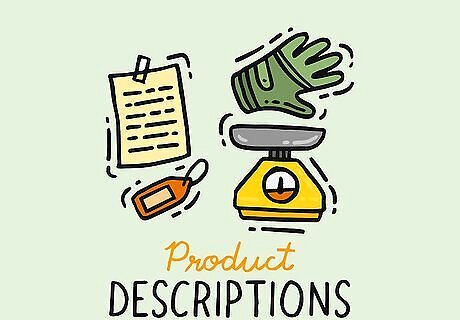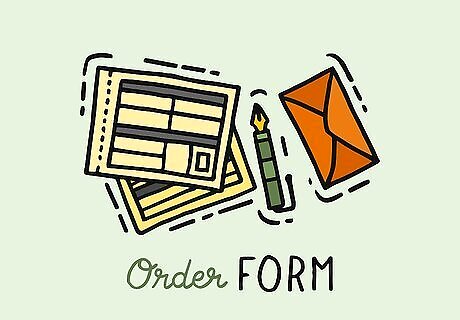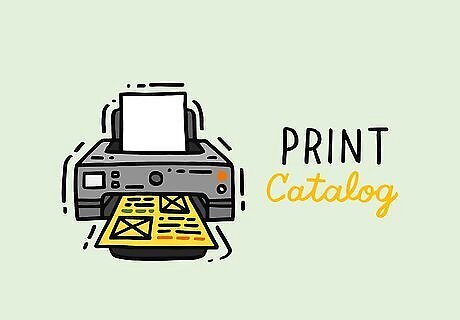
views

Gather your content. Make sure you have all of the ingredients in place before beginning any design steps. The content you'll need before you make the catalog includes images of the products, a list of products and product features, and a list of other content that needs to be written, such as information about the company, customer testimonials, and any other information that will help your customers make the right decision.

Produce visually appealing product images. You may be tempted to take your own images to save money, but unless you yourself are a professional photographer, it's best to hire a professional to take images for you. Your product photographs are one of the most important aspects of the catalog since this is what customers will see first. An appealing image will encourage customers to read the description and, hopefully, make a purchase. If you have photography skills and feel comfortable taking the pictures yourself and own a digital camera, set the camera on the highest resolution and follow product picture protocol: use individual, not group pictures of products on a light background, add a drop shadow to make the products leap off of the page, and upload them at no lower than 300 dpi. Try to get high-quality pictures from multiple angles and perspectives.

Know your product features. Before you write the content about each product, you'll need to know all of the technical specifications of each one. You can also assign item numbers and prices, including original and discount prices. You may also want to jot down any benefits that come to mind while sorting through your products. Though you may want to tell readers every little thing there is to know about each product, you should only give them the information that will help them make a decision. You can direct them to your website if they want even more information about the product.

Choose an appropriate size for your catalog. You should pick a convenient size for your catalog to be when it's closed. Depending on where it will be used, whether it's on an airplane or on a desk in a waiting room, you'll need to consider the most convenient size for your product so your customers aren't overwhelmed by an overly-large catalog or aren't frustrated by a catalog that is too small to let them clearly see the images and information about the products they are considering.

Choose the right amount of pages. Your catalog needs to be long enough to give your customers all the information they need, but short enough to keep their interest and to not bog them down in extra details. Don't forget about a table of contents, any products that may be featured on an entire page, and additional informational pages, such as the company history. Make sure that your pagination is consistent. You can make it easy for customers to find your website address and number by putting them on each of your two-page spreads. You can list your phone number on the bottom right of each page and your website URL on the bottom left, or do the reverse. You can also place one on the top or one on the bottom. Be sure to keep the page count in 4 page increments since printing companies print 4 pages on an entire sheet of paper (2 on the front and 2 on the back).

Write product descriptions. Keep each description short, between 50-150 words. You will want to include the features of each product, but be sure to tie small benefits into each feature. And don't forget about a core benefit. For instance, the grip features of those golfing gloves will provide a more stable hold on the club, but more importantly, customers can golf on a pro-level when wearing these gloves (core benefit). Help customers select the right item as you are writing about the products, describing what they need to know about them, from price to weight or dimensions. If you'd like additional writing help, you may consider hiring a copywriter. Usually, no detail is too small when you're describing your products.

Write the additional content. When you're copywriting, you should use short, easy-to-read sentences and paragraphs that avoid overly technical language. Each section of your catalog should have a cover or introductory page that shows a person using one of the products in the section, along with a short article about the benefits of the entire product category. Your content can also include a brief history of the company to make your readers feel more comfortable with your products. You should also create the order form if you will accept faxed or mailed orders.

Organize your content. You'll need to plan which content will appear on each page. Be sure to place similar products together. Additionally, you should place products that go together near each other as well. For example, if you're selling upscale men's dress shoes, you may place shoehorns that will keep the shoes intact for a long time on the same page, because customers who consider nice shoes may be looking for this as well. This is also a great way to show customers something that they didn't even know they needed. To organize your content effectively, you'll need to not only have product sections, but an introductory section at the front of the book, an educational section if you want to include articles, as well as a section for return and warranty information. You can intersperse articles throughout the catalog so that buying your products is never far from the customer's mind. Make sure to use consistent typography and designs so your customers aren't distracted. However, you should make it convenient to find a specific section by color-coding the tops, bottoms, or sides of the pages of each section.

Use powerful fillers. When you're trying to reach a 4-page increment, you may need to use some filler pages in your catalog. Make these fillers promote the purpose of your catalog -- selling products. Including the history of your company will help customers be more comfortable buying your products. So will customer testimonials and guarantees. Anything that will put a customer's mind at ease and legitimize your company will help you make the most of extra real estate.

Create an impressive cover. The cover will be the first thing your potential customers see and it will make or break the success of your catalog. If your cover does not capture attention, the catalog may get thrown in the trash before a customer even opens it. Including feature items, any specials or discounts, and stunning images all encourage a consumer to flip through the pages. If your catalog is seasonal, go with a theme that matches the time of year or an upcoming holiday.

Design an order form. Although creating the order form can be a bit tedious, keep in mind that a customer may give up on buying that one-of-a-kind lamp because the form is too confusing. Including a customer service number will give customers a way to contact you if they get stuck. A perforated form that is addressed makes mailing the order much easier for customers as well. Don't forget necessities such as a quantity option and both shipping and billing address options. If your customers can also order the product online, let them know that this is an option.

Create a mock-up. It's important to create a mock-up of your product catalog before you order hundreds of catalogs and realize you've made some organizational errors or visual mistakes. This process will keep you from wasting time on redoing page layouts, and it will give you a sense of what your catalog will actually look like. Unless you have a graphic design background, you should hire or meet with a professional to find the best way to lay out the pages in your catalog. You will discuss your budget, the printer you will use, any tear-out order forms, and the images you want to use. Once you or your graphic design expert will have a sense of these components, you can find a way to lay out the information, and a way to place as many products as you can on one page without crowding them. You can use shapes or other placeholders to represent the images you will eventually use. Once you have everything ready, you can even use the real images, proof the catalog, and have potential buyers take a look at it to get some suggestions before you take it to your printer.

Print your catalog. If your catalog is only 4 pages, you could try printing it yourself, but a professional will take less time and ensure quality results. Plus, a commercial printing firm will take care of issues such as page implementation (page order) and creep (outer pages coming out shorter than the inner pages when folded together). A printer will also be able use a much more durable binding technique. Some printing companies even provide mailing services for your convenience. Just make sure to find a printer that you can trust for reasonable prices and professional quality.



















Comments
0 comment